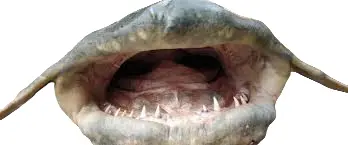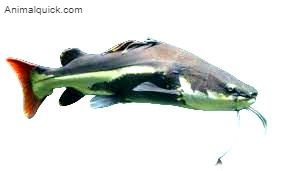Catfish is a very famous species in the USA.
Let’s find out if they have teeth or not!
Do Catfish Have Teeth? Yes, Catfish have tiny, rough teeth in their throat called pharyngeal teeth.
These teeth help them hold onto and crush their food, like shellfish and small fish.
Do Catfish Have Teeth?
Yes, catfish do have teeth, but how their teeth are shaped and what they do can be different depending on the type of catfish.
- Teethpads: Most catfish possess small, bristle-like teeth known as “teethpads” in their mouths.
- Function: These toothpads are used for grasping and holding onto prey rather than for chewing.
- Feeding Behavior: Catfish typically use their teeth for gripping and swallowing food whole or tearing it into smaller pieces.
- Variability: The size and arrangement of teeth can vary among catfish species based on their specific diets and feeding behaviors.
- Herbivorous Adaptation: Some catfish are primarily herbivores, and their teeth may be adapted for scraping and grinding plant material.
Do Catfish Bite Humans?
No, catfish do not bite humans, as they are not mean to people, and they’re not a big danger.
But sometimes, they might bite if they feel scared or mistake a person’s hand for food.
This is more likely to happen when people are trying to catch them.
- Potential Venom: Some catfish species may carry venom in their spines, leading to pain if a person is pricked.
- Handling Precautions: To prevent injury, it is advisable to handle catfish gently and with caution.
- Appropriate Equipment: Using the right equipment, such as gloves, can provide a protective barrier and reduce the risk of injury.
- Awareness of Spines: Being aware of the location of catfish spines and handling them with care helps minimize the likelihood of getting hurt.
Can Catfish Bite Your Finger Off?
No, catfish maybe can not bite your finger off.
Catfish have strong jaws and sharp teeth, but their bites are usually not strong enough to cut off a human finger.
- Caution with Bigger Catfish: Exercise extra caution when handling larger catfish, especially those with robust spines.
- Injury Potential: The spines on the back and side fins of some catfish can cause injuries, including piercing the skin, leading to pain, swelling, and a potential risk of infection.
- Protective Gear: Using appropriate gear, such as gloves, can provide a protective barrier against potential harm.
- Low Probability of Biting: While the likelihood of a catfish biting off a finger is very low, maintaining caution and respect toward the animals is crucial for safe interactions.
Do Catfish Bites Hurt?
Yes, catfish bites can hurt.
Catfish have strong jaws and sharp, barbed spines on their back and side fins.
When they bite, those spines can pierce the skin and cause a lot of discomfort.
- Muscular Mouths: Catfish are known for their strong and muscular mouths, making their bites potentially forceful.
- Hook Removal: Careful and gentle removal of the hook is essential to minimize the risk of injury from catfish spines.
What Do Catfish Teeth Look Like?

Catfish have small, sharp, and backward-facing teeth that are adapted for holding onto prey and preventing them from escaping.
These teeth are typically arranged in rows on the upper and lower jaw.
Some catfish species have long, slender, and curved teeth, while others have shorter and broader teeth.
The size and shape of catfish teeth also depend on their feeding habits and diet.
What If a Catfish Bites You?
If a catfish bites you, stay calm, remove the hook, control the bleeding, clean the wound, and seek medical assistance.
- Stay Calm: Try to stay calm to avoid making things worse.
- Remove the Hook: If the catfish bit and hooked you, use pliers to carefully take the hook out the same way it went in.
- Control Bleeding: If there’s bleeding, press a clean cloth or bandage on the wound. If possible, raise the affected part of your body.
- Clean the Wound: Wash the wound with soap and water. If you can, use an antiseptic to disinfect it.
- Watch for Signs of Infection: Keep an eye on the wound for signs of infection like increased redness, swelling, pain, or discharge. If you see any, get medical help.
- Seek Medical Attention: If the wound is deep, bleeding a lot, or you’re worried about infection, see a doctor. Catfish bites can introduce bacteria, leading to infections.
- Update Tetanus Vaccination: If your tetanus shot isn’t current, consider getting one. Catfish bites, especially punctures, can raise the risk of tetanus.
- Apply Antibiotic Ointment: After cleaning, put on antibiotic ointment and cover the wound with a clean bandage to help it heal and prevent infection.
What Do Catfish Bite the Most?
Catfish bite the most on live or cut bait, stink baits, worms, chicken liver, shrimp, and cheese baits.
- Live or Cut Bait: Using live bait like minnows, shad, or sunfish can work well. Cut bait, which is slices of fish such as mullet, shad, or bluegill, is also a common choice.
- Stink Baits: Stink baits are ready-made baits with a strong smell that can pull catfish from a distance. They usually come as dough or dip.
- Worms: Nightcrawlers or other kinds of worms can be good for catfish, especially the smaller ones.
- Chicken Liver: Catfish are drawn to the scent of chicken liver, making it a popular and affordable bait.
- Shrimp: Fresh or frozen shrimp can be effective, especially for channel catfish.
- Cheese Baits: Some people use cheese baits, either homemade or store-bought, for catfish.
- Dip Baits: Dip baits are often used with a sponge or fiber-based rigs. They stick to the bait holder and slowly release scent into the water.
- Blood Baits: Baits made from blood or blood-based products can also work well for catfish.
What Part of a Catfish Should You Not Touch?
The parts of a catfish that you should not touch are the dorsal and pectoral fins, which are on the top and sides of the fish.
These fins have sharp spines that can cause injury.
When Do Catfish Bite?
Catfish bite in the evening and night at the right water temperature in the flowing water.
- Evening and Night: Larger catfish, such as flatheads and channel catfish, are often more active during the evening and night, especially in low-light conditions.
- Warm Water Temperatures: Catfish are generally more active in warmer water. In summer, when water temperatures rise, catfish are more likely to be active and feeding.
- Pre-Spawn and Post-Spawn: In spring, before and after the spawn, catfish are more active and may be found in shallower areas.
- Overcast Days: Catfish may be more active on cloudy days. Reduced light can make them feel secure, encouraging them to venture out for food.
- Flowing Water: In rivers and streams, catfish may be more active with a steady water flow, often around structures like rocks or deep holes.
- Feeding Windows: Catfish can be opportunistic feeders, and there might be specific “feeding windows” coinciding with changing light conditions or other environmental factors.
How Many Teeth Do Catfish Have?
Catfish do have teeth, but the number and structure of their teeth can differ among species.
For example:
- Channel Catfish: Channels have rows of small, sharp teeth in their upper and lower jaws, suitable for gripping prey like fish or other aquatic organisms.
- Flathead Catfish: Flatheads have fewer but larger and flatter teeth, better for grasping and crushing prey such as fish or crayfish.
- Blue Catfish: Blues typically have numerous small, needle-like teeth, used for holding onto prey while swallowing it whole.
What Kind of Teeth Do Catfish Have?
Catfish have teeth specially adapted to their feeding habits, and the characteristics of their teeth can differ among species.
- Small, Needle-Like Teeth: Many catfish species, like blue catfish, have numerous small, needle-like teeth. These teeth are designed for gripping and holding onto prey.
- Multitude of Villiform Teeth: Villiform teeth are tiny, brush-like teeth in rows along the jaws of some catfish. These teeth are well-suited for grasping small prey like insects, larvae, and smaller fish.
- Large, Flattened Teeth: Some catfish, such as flathead catfish (Pylodictis olivaris), have fewer but larger and flatter teeth. These teeth are adapted for crushing and grasping larger prey like fish or crustaceans.
- Adaptations for Swallowing: Catfish teeth aren’t used for chewing; they’re designed to hold onto prey while the catfish swallows its food whole. To aid in swallowing, catfish often have backward-facing spines in their mouths to prevent prey from escaping.
What Catfish Has Sharp Teeth?
Flathead Catfish are known for having more sharp teeth compared to others.
Flatheads have relatively large, broad, and flat teeth adapted for grasping and holding onto their prey, which includes fish, crustaceans, and other aquatic organisms.
While the teeth of the Flathead Catfish are not as pointed as those of some other predatory fish, they can still cause injury if not handled carefully.
Do All Catfish Species Have Teeth?
Some catfish have visible teeth, others may possess specialized structures in their mouths adapted for feeding without having visible external teeth.
- Channel Catfish: Channel catfish have small, sharp teeth, often arranged in rows along their upper and lower jaws.
- Blue Catfish: Blue catfish typically have numerous small, needle-like teeth designed for gripping prey.
- Flathead Catfish: Flathead catfish have fewer but larger and more flattened teeth adapted for grasping and crushing prey.
- Corydoras Catfish: Many species of Corydoras catfish, often found in aquariums, have specialized structures called odontodes that serve functions similar to teeth but are not true teeth.
- Electric Catfish: Electric catfish have specialized jaw structures with small, bristle-like structures used for sensing prey and detecting electric fields.
How Do Catfish Eat Their Food?
Catfish eat their food by capturing, taking position for swallowing, and then digestion.
- Capture and Grasp: Catfish use their keen senses to locate prey. When potential prey is detected, catfish move in to capture it. Their teeth, whether small and numerous or larger and flattened, are employed to grasp and hold onto the prey.
- Securing the Prey: After capturing prey, catfish use their teeth and specialized mouth structures, such as backward-facing spines, to secure it, preventing escape.
- Positioning for Swallowing: The catfish manipulates the prey in its mouth to position it for swallowing. While catfish don’t chew, their teeth play a crucial role in gripping and guiding the prey into the right position.
- Swallowing Whole: Catfish lack chewing mechanisms, and their throats accommodate the passage of relatively large prey. Once positioned correctly, the catfish swallows the prey whole.
- Digestion: The swallowed prey moves through the catfish’s digestive tract, where it breaks down, and nutrients are absorbed. Catfish have simple digestive systems capable of handling various prey types.
Also, read:
- What Do Catfish Eat?
- Why Are Blue Catfish a Problem?
- When Blue Catfish Become Blue?
- Can Catfish Live Without an Air Pump?
- Can a Catfish Walk on Land?
H2: FAQs
Do Bristle Nose Catfish Have Teeth?
Yes, Bristle Nose Catfish have small, comb-like teeth called odontodes, primarily used for scraping algae and detritus from surfaces.
Do Big Catfish Have Teeth?
Big catfish, like many others, have teeth in the form of small, backward-facing structures used for grasping prey, but they are not as prominent as in some species.
Do Cory Catfish Have Teeth?
Cory Catfish possess tiny, tooth-like structures in their jaws, mainly for nibbling on small particles and invertebrates in the substrate.
Do Flathead Catfish Have Teeth?
Yes, Flathead Catfish have noticeable teeth, especially in the upper jaw, adapted for gripping and consuming a variety of prey.
Do Red tail catfish have teeth?
Red Tail Catfish have teeth that are sharp and conical, suitable for capturing and consuming a diverse diet, including fish and invertebrates.
Do saltwater catfish have teeth?
Some saltwater catfish species have teeth, though the presence and structure may vary. They are generally adapted for capturing prey in their marine environment.
Do tiger shovelnose catfish have teeth?
Yes, Tiger Shovelnose Catfish have small, pointed teeth. These are adapted for gripping and consuming a variety of prey in their freshwater habitats.
Do wels catfish have teeth?
Wels Catfish have well-developed teeth, including large, molar-like pharyngeal teeth and smaller teeth in the jaw, aiding in capturing and consuming various prey.
Do all catfish have teeth?
While tooth structure varies, most catfish species have teeth, ranging from small, pointed teeth to more specialized structures adapted to their feeding habits.
Do Channel Catfish Have Teeth?
Yes, Channel Catfish have small, pointed teeth designed for gripping and consuming a variety of prey, including fish, insects, and crustaceans.
Do Bullhead Catfish Have Teeth?
Bullhead Catfish have teeth, typically small and arranged in multiple rows. These teeth assist in grasping and consuming a diverse diet of prey.
Why Do Catfish Have Teeth?
Catfish have teeth to catch and eat their food. The teeth help them grab onto smaller fish and other creatures in the water so they can have a meal.

I love animals & want to know more about different creatures & sharing their stories with everyone. From my childhood, I’ve been exploring forests & watching animals in their homes.
Now, I write about my adventures & all the amazing things I learned. My blogs are easy to understand & make you want to know more about animals. I teach about why animals are important & why we should take care of them.

